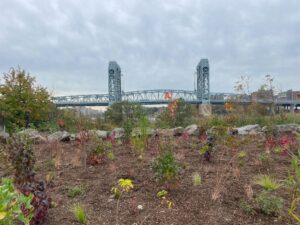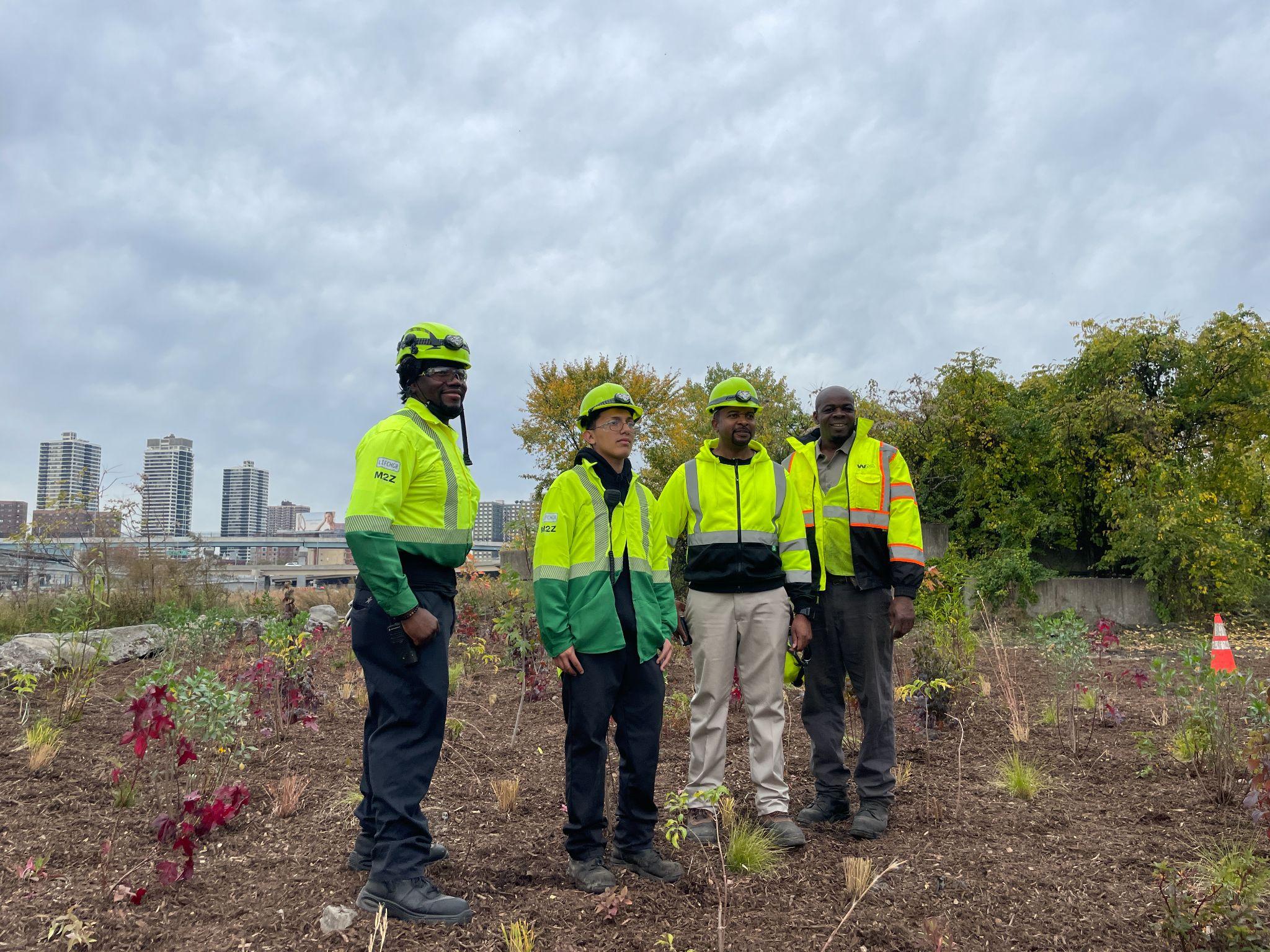In September, floods swept the South Bronx and much of the city in a whirlwind of rainwater, reminding New Yorkers of the importance of coastal resiliency, which the city has struggled with in recent years.
Waste Management, the private waste transfer facility off the Bruckner Boulevard and along the Harlem River, took a first swing at that last month, when they planted a microforest with 500 indigenous trees and shrubs to help protect against floods and enhance a biodiverse environment.
The waste company’s staff and 15 teen volunteers from the Dream Charter School right next door geared up in fluorescent green vests to help plant the diverse shrubbery. The teens took the project to heart, according to Student Life Director Carlos Grimes, with one student citing the high asthma rates in the Bronx as motivation for planting the trees.
“We want our students to be critically conscious adults,” said Colleen Doran, director of corporate partnerships at Dream.
Dream taught students the importance of having a “green thumb,” a common term for those who grow plants successfully, and about New York City’s lack of green space, Grimes and Doran said. The learning will continue next fall, when plans call for students to come back to the microforest and see the progress they’ve made.
To build out the 3,000-square-foot microforest, Waste Management contracted the Wildlife Habitat Council, but the company will oversee its long term management. This kind of landscaping is a new and exciting approach to forestation and habitat restoration, said Jacque Williamson, senior consultant to the Wildlife Habitat Council.
Microforests are dense, tiny forests with high biodiversity. They are a form of forestation created from ground zero. They also grow faster, which means they reach maturity four times faster over 25 years than a typical forest.
By placing plants so close together, Williamson said, you create a forced competition that maximizes plant reproduction and causes them to grow more quickly.
“You could almost call it aggressive forestry,” she said.

Over time, the trees’ roots lock up the soil so in the event of heavy rain, they act as a natural barrier to rising river water and help prevent inundation.
Not all experts are as sold on micro forests as a magical solution. Richard Hallett, a research ecologist for the U.S. Forestry Service who has been studying urban forestry for 13 years, said that despite the recent popularity of microforests, there isn’t a lot of rigorous scientific research on how to ensure their success.
“More work needs to be done in understanding the best approach,” Hallett said. “I don’t think it’s a cookie cutter kind of thing, and I worry a little bit that these mini forests are being used as the solution without thinking, ‘what are your goals for this site?’”
Hallett worries about long-term sustainability. Close planting may be fine in the short term, but can require thinning later in order to prevent close competition from damaging the health of the trees. These effects have been observed following mass tree planting efforts like MillionTreesNYC that heavily increased tree coverage, but didn’t always optimize spacing and maintenance.
For urban forests to be successful, stewards have to consider factors like invasive species, weather impacts, compacted soils, chemical environments, and even deer.
“Once the tree is in the ground, your work has really just begun,” Hallett said.
Successful long term urban forestry efforts are deemed important to the vulnerable South Bronx. As of 2023, 45% of properties in MottHaven’s 10451 zip code are at severe risk of flooding in the next 30 years, compared to 25% of properties in Bronx County according to First Street Foundation’s Risk Factor computations. More trees, plants and shrubbery, which are called for in green infrastructure and coastal resiliency plans, can help lower the risks of flooding by absorbing rainwater and reducing erosion.
Coastal resilience refers to a community’s ability to “bounce back” from hurricanes, coastal storms and flooding rather than simply reacting to its impacts,” according to the National Ocean Service.
“Trees and coastal shrubs provide a physical barrier against surges in storms and high waves that helps reduce coastal erosion and damages to real estate,” said Martin Smit, a corporate sustainability consultant at PwC.
“Soil stabilization and water absorption is another benefit from trees, because they essentially make the earth act like a sponge which reduces the severity of floods,” said Smit.
Nonprofits like The Bronx is Blooming and MillionTreesNYC have successfully increased the South Bronx’s tree canopy coverage to 3.42% after planting more than 7,600 trees between 2010 and 2017, according to a 2021 report from the Nature Conservancy.
Not only do more trees help absorb rainwater and prevent flooding, they can help clean the air. The Arbor Day Foundation reports that a mature tree can absorb more than 48 pounds of carbon dioxide in one year and release oxygen in exchange.
This is important in the South Bronx, where the Mott Haven and Hunts Point neighborhoods rank in the bottom third for outdoor air quality in New York. Nicknamed “asthma alley,” Mott Haven has the highest asthma rate in New York City and one of the highest in the nation.
Beyond the microforest’s hoped-for environmental impact, for Waste Management staff – many of whom are Bronx natives – the microforest will be a respite amid the chaos of the waste facility, which receives over 300 trucks of waste a day.
Despite its proximity to waste, there is no foul smell in the forest. Instead, the freshly planted silver maples, American beachgrass, and Virginia rose plants fill the air with crisp, leafy scents.
Waste Management employees are thinking of setting up their “100 days of Summer” BBQ at an open area in the microforest. They are also thinking of glamming it up with art murals.
“We can paint one yellow and one green,” said Site Supervisor Orlin Fernandez about the rocks separating the microforest from the driveway. “And on that wall over there, we can do graffiti.”
Though the microforest won’t be open to the public, its aim is to contribute to the restoration of the broader ecosystem of the South Bronx’s Harlem River. As the Bronx waterfront is rapidly developed, implementing and maintaining greenspace in the neighborhood is considered critical.

